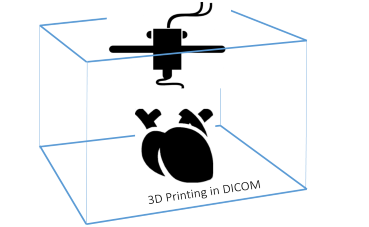
Sup175
2nd Gen. C-Arm RT Treatment
This Supplement introduces the RT Radiation Set and representation of the C-Arm techniques.
An RT Radiation Set IOD defines a Radiotherapy Treatment Fraction as a collection of instances of RT Radiation IODs.
Further this supplement adds support for C-Arm Photon-Electron Radiation instances.
RT Radiation IODs represent different treatment modalities.
This supplement was voted as Final Text and will be part of the next edition of the standard.

Sup176
2nd Gen. Other non C-Arm RT Treatment
The scope of this supplement is the introduction of new RT Radiation IODs for non-C-Arm treatment devices.
This supplement adds support for instances of the following RT devices:
- Tomotherapeutic Radiation
- Multiple Fixed Source Radiation
- Robotic Radiation Storage
This supplement will be revisited and presented in upcoming base standard meetings. It is getting close to Letter Ballot voting. View details »

Sup208
Encapsulated Additional Models 3D Manufacturing
This supplement extends the DICOM standard to better address encapsulation and color grouping of medical 3D manufacturing.
It also addresses new uses of medical DICOM data in the fields of Virtual Reality, Augmented Reality, and Mixed Reality.
These extensions fall in three areas:
1) Support for a new 3D model type: Object File (OBJ)
2) Identification which models a part of a group intended for assembly into a larger object
3) Persistently indicating a preferred color for manufacturing or display of a model
OBJ Encapsulation
The supplement will incorporate Object Files (OBJ) and any supporting Material Library Files (MTL) and texture map files (JPG or PNG) referenced from the OBJ files.
Grouping by Assembly and Component Color
Support is added to distinguish groups of models that are parts of the same assembly, from other models that are not.
This supplement was voted ready for Public Comment voting.
View slideset »

Sup193
Web Services Notification
This supplement defines a generalized abstract API for sending and subscribing to notifications about RESTful resources.
The Notifications API defines Subscribers, Subscriptions, Events and Event Reports.
- Notifications about Worklist Workitems, already in the Worklist API, but they are modified to conform to the new API.
- Notifications about the state of a Worklist Service.
- Notifications about the existence and state of data resources in the Patient, Study, Series, and Instance hierarchy.
Security is beyond the scope of this supplement. However generic Web security mechanisms are fully compatible.
Supplement 193 will be further presented and discussed with the Base Working Group in a coming meeting before Public Comment voting. View details »
View slideset »

Sup209
DICOM Conformance Statement
This supplement focuses on rewriting part two, DICOM conformance, of the standard.
The goal is to achieve better interoperability and machine processing of DICOM conformance statements.
It was considered advantageous if the template is a separate generated MS Word template.
Supplement 209 will be further presented and discussed with the Base Working Group in a coming meeting before Public Comment voting.





